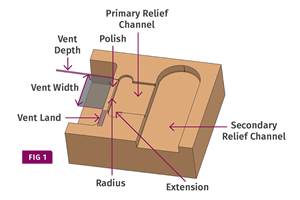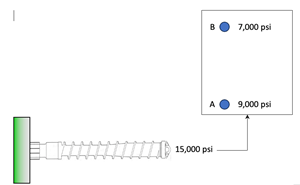Sensors Targeting Hot Runners and Additive Manufacturing and More
Kistler showcased a new sensor capable of being deployed directly on hot runner nozzles, as well as other sensor and process monitoring advances.
At K 2022, Kistler unveiled the new 4004A pressure sensor targeting hot runner applications and additive manufacturing. With an operational and measurement range up to 350°C, this piezoresistive sensor can be deployed directly on hot runner injection nozzles, or at a printer head, opening the way to precise characterization of these processes in the future. This ultra-compact sensor has a front diameter of only 3 mm and is available with three measuring ranges 500, 1000 and 2500 bar (approx. 7250, 14,500 and 36,000 psi). In addition, it includes TEDS (transducer electronic data sheets) and can be connected via an adapter to as many as three additional sensors to create one measuring unit.

The new 4004A pressure sensor is small enough to target hot runner applications and additive manufacturing.
Photo Credit: Plastics Technology
The company also debuted its new Type 2205B temperature amplifier to amplify signals from a range of thermocouples and relay them to the ComoNeo process monitoring system. The new temperature amplifier works with types J, K and N Kistler thermocouples. A version with eight input channels that can be used individually is also available. Featuring the same dimensions as its predecessor, the new temperature amplifier can be retrofitted for older models.
The 6196A, 6197A and 6198A thermocouples feature a measuring range from 0 to 400°C using short response times, for fast, reliable detection of deviations in the process such as flow fluctuations or blocked cooling channels. In addition, the 9239B cavity pressure sensor has added some new features. Especially suited for use in optical component production and decorative applications where no markings are permitted on the surface of the parts, this sensor can detect even the smallest pressures through the closed mold wall.
On the process monitoring front and given the increasing use of recycled materials, Kistler notes the growing role of process control. Kistler’s latest ComoNeo process monitoring system, version 4.1, evaluates process data collected by cavity pressure and temperature sensors to enable accurate monitoring of injection molding. Kistler says with the new version monitoring of the pressure curve in all cavities is now more precise thanks to an envelope curve adapted to the process. In addition, the new version has WLAN capability for the first time and comes with additional interfaces. Launched at K, version 5.0 offers upgraded hot runner balancing utilizing ComoNeoMULTIFLOW and EUROMAP 82.2, the latest communication standard, in addition to export and communication interfaces.

Kistler says version 5.0 of its ComoNeo process monitoring system offers upgraded hot runner balancing capabilities.
Photo Credit: Kistler
The online quality prediction system, ComoNeoPREDICT, enables manufacturers to optimize the molding process with the help of artificial intelligence. On the basis of the current cavity pressure profile, the system can analyze every manufactured part, making it possible to optimize the machine settings.
The new ComoScout was also at K 2022. As opposed to the ComoNeo, this system does not measure cavity pressure but instead monitors voltage signals from the injection molding machine and from sensors up to 10 volts. Kistler says monitoring these machine parameters opens up a new range of applications to manufacturers previously hesitant about investing in process monitoring.
Related Content
Back to Basics on Mold Venting (Part 2: Shape, Dimensions, Details)
Here’s how to get the most out of your stationary mold vents.
Read MoreUse These 7 Parameters to Unravel the Melt Temperature Mystery
Despite its integral role in a stable process and consistent parts, true melt temperature in injection molding can be an enigma. Learning more about these seven parameters may help you solve the puzzle.
Read MoreUsing Data to Pinpoint Cosmetic Defect Causes in Injection Molded Parts
Taking a step back and identifying the root cause of a cosmetic flaw can help molders focus on what corrective actions need to be taken.
Read MoreUnderstanding the Effect of Pressure Losses on Injection Molded Parts
The compressibility of plastics as a class of materials means the pressure punched into the machine control and the pressure the melt experiences at the end of fill within the mold will be very different. What does this difference mean for process consistency and part quality?
Read MoreRead Next
Beyond Prototypes: 8 Ways the Plastics Industry Is Using 3D Printing
Plastics processors are finding applications for 3D printing around the plant and across the supply chain. Here are 8 examples to look for at NPE2024.
Read MoreSee Recyclers Close the Loop on Trade Show Production Scrap at NPE2024
A collaboration between show organizer PLASTICS, recycler CPR and size reduction experts WEIMA and Conair recovered and recycled all production scrap at NPE2024.
Read MoreFor PLASTICS' CEO Seaholm, NPE to Shine Light on Sustainability Successes
With advocacy, communication and sustainability as three main pillars, Seaholm leads a trade association to NPE that ‘is more active today than we have ever been.’
Read More












